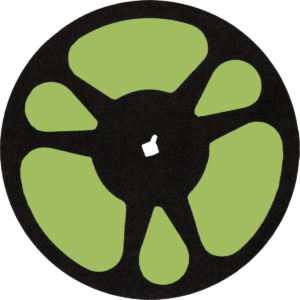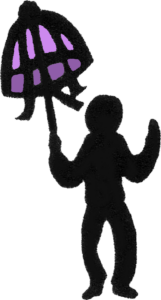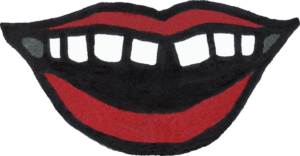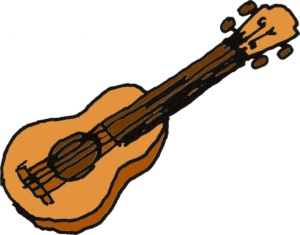On the Making of The Blues According to Lightnin’ Hopkins
The Making of The Blues According to Lightnin’ Hopkins
by Les Blank
(Written for the Program IX: The International Festival of Ethnographic Films
Nuoro, Sardinia, Italy, 1998)
I grew up in Tampa, Florida in a white, upper-middle class home and distinctly remember the first live music I ever experienced. It was a neighbor practising on his trombone. I became transfixed and transported by the deep rich tones of the horn and the beauty of the shiny silver instrument. I later took up playing trumpet in school and was the bugler for the daily raising and lowering ceremonies of the American flag. But, when I was 15, I had to make a choice between performing in the band and playing football. I chose the latter and gave up playing music. (I wasn’t really that good at it, never learning to play by ear.) But music became more and more important to me as I discovered entirely new worlds that were shaped by the central core of musical performance. I became fascinated by eery and ecstatic African-American baptism ceremonies in the river of downtown Tampa, the country music dance halls packed with hard-drinking, loud, working-class descendants of Scotch-Irish immigrants and infectiously rhytmic Cuban-American rumba music blaring from the hand-rolled cigar factories of the Cuban part of town. In my teens, when I went away to high school in the ’50s, I gravitated to the smokey, late night jazz clubs in New York and Boston, where I enjoyed abandoning whatever cares I had to the hot music, cold beer and wild women found therein.
When I began my University studies at Tulane University in New Orleans, I found not only abundant opportunities for drinking and dancing until dawn in all -night bars in the French Quarter, but a rich party life in the streets occasioned by periodic jazz funerals, and the many other occasions that call for someone buying a keg of beer and hiring a jazz band to parade around with. The presence of a band in the street in New Orleans is an open invitation to all to join in and dance along, no matter how rich or poor, or what color the skin. The people dancing along with the band are called the “second line”, (the first line being the band itself), and they come from their houses or bars or places of work when they hear the music coming. Like a sudden, cooling rain shower when it is insufferably hot and humid, the unexpected second-line parade affords a welcome opportunity to take off that coat and tie, or leave an ailing, nagging wife or unpayable rent notice or whatever else is holding a person down, and to get out, in the street and dance it all out. I also liked that many of these spontaneous non-funeral parades had no destination and no apparent purpose except immediate pleasure.
It wasn’t long before I had to make a choice between playing football and partying. I chose the latter while recovering from a severe concussion after falling on my head from a float during a Mardi Gras parade. I also decided not to ride on any more floats in parades, but to keep my feet on the ground as a second-liner. This way, I wouldn’t have as far to fall and it was a hell of a lot more fun. (I didn’t know it then, but all this carousing was actually serving a purpose. Twenty years later I would return with camera in hand and spend three months during the Carnival season documenting party life in the streets of New Orleans to make Always For Pleasure.) Somehow, I managed to complete my studies in literature and theater in New Orleans, and failing to publish any of my poems and stories, I abandoned dreams of being a writer and went to California to try my hand at films. Based on a positive recommendation for my work in theater at Tulane University, I had been offered a graduate fellowship to study for a Ph.D. in Communications at the University of Southern California in Los Angeles.
I thought I had wanted to follow in the footsteps of my great Italian heroes, Federico Fellini and Vittorio De Sica, but after two years in film school, where I was exposed to non-fiction film making, I found myself gravitating toward documentaries. My love for jazz and a lot of serendipitous luck led to making Dizzy Gillespie in 1964, and continuing to follow my nose, I made a short film on the late sixties phenomenon known as “love-ins”. Here, young people came together in an uninhibited environment to share sudden friendship and uninhibited self-expression with hundreds of others who had had it with the restricting material culture of the 50’s. A growing sense that the war in Viet Nam was wrong led to protests, and life styles were rapidly changing. Sex, drugs and rock and roll played no small part in the celebratory patterns of these young people known as ” flower children”. My resulting film, God Respects Us When We Work, But Loves Us When We Dance was well-received at film festivals and I began to think about what to do next.
I shot for no pay on independent films on the early Renaissance Craft and Pleasure Faires (Pleasure Faire), hot rod and drag racing (The Seven Second Love Affair) and an unfinished film on outlaw motorcycle gangs that nearly finished me off. Meanwhile, my favorite entertainment had become hanging around the Ash Grove, a night club in Los Angeles that featured folk music, much of it protest songs by singer-song writers of the 60’s, but also very special people on tour, like blues singers Brownie McGee and Sonny Terry and, my favorite, Lightnin’ Hopkins. At the time, my second marriage had recently collapsed and I felt myself a failure as a father, a human and an artist. My future as a film maker seemed a hollow, hopeless void. Listening to the blues being performed by those who had truly lived the blues, provided an escape from my problems and also gave me a strong sense of connection to pain and suffering, even though I had not been born into a world beleagered for generations by racism, poverty and gross injustice. I found that really listening to blues music provided a kind of comfort not experienced since my younger days as a believer in organized religion. (A couple shots of whisky and a beer or two helped the process along, numbing the fears of getting close to the source of my deepest sorrows and anxieties.) When Lightnin’ sang about how bad he felt when his woman left him, I was able to cry in my beer and also calm somewhat the inner terror of my chaotic soul.
Wanting more of this peace-giving pleasure in my life and also the opportunity to make a film that counted, I approached Lightnin’ Hopkins backstage with a 16mm projector and a copy of my film on Dizzy Gillespie and proposed to go to his home in Texas and do a film on him if he liked the Dizzy film and if we could agree on how much he’d be paid. Fortunately, my apprentice at the time had access to a loan for enough cash to satisfy Mr. Hopkins and also to pay for film stock and enough gas to get us to Texas. He liked the film on Dizzy OK, too. In Houston, we found a free place to stay, on a friend’s floor, made a partial payment to Lightnin’ and began to immerse ourselves in the life and music of Lightnin’, with the help of local folklorist John Lomax, Jr.,( brother of folklorists Alan and son of John, Sr.) the only white man that Lightnin’ was known to trust. At the end of the first day of filming, Lightnin’ told us he had sung 10 songs for us that day and felt that was “plenty enough” for us and that he was sick and tired of having us hanging around filming and recording everything that he did said and sung. He then demanded that we pay him the balance of what we owed him and go back to California.
While packing up the camera equipment and feeling overwhelmed by disappointment and despair over not having enough material for a decent film, I noticed that Lightnin’ had become very engaged in a card game. I asked him what the game was and he offered to show me how to play. Soon, he asked me to bet some money and play for real. I quickly lost all the cash I had and became even more depressed. Lightnin’ found this very amusing and invited us to return the following day for more card playing. After borrowing some more money and losing it just as quickly as the night before, I sadly contemplated the fix I was in. Lightnin’ chuckled victoriously and said that maybe we weren’t so bad after all, and allowed us to hang around for another six weeks of shooting, carefully choosing our moments to be with him and avoiding him when he began to show signs of crankiness. Also, I didn’t play any more cards with the master, at least, not until after the film was all shot and edited. And then, I always lost, no matter how hard I tried, or how carefully I checked to see if and how he might be cheating. He always seemed to know what cards I had in my hand. Lightnin’s apparent omniscience was a constant source of surprise for me. He was like an ancient oracle in his uncanny ability to improvise rhyming blues songs about a person or situation that revealed a truth that was perfect in its simplicity, yet infinitely complex in its layers of meaning.
You make your bed hard, baby,
and calls it ease.
The blues is just a funny feelin’,
yet some folks calls it a mighty bad disease.
This line was composed late one night while I was filming what started out to be an ordinary interview. I had asked him to tell me what the blues meant to him. He picked up his guitar and started to sing about a woman named Mary who had left him. Earlier that evening his wife had left him after a nasty argument that caused her cousin to attempt to shoot Lightnin’. While the song was being sung, the cousin was lurking outside the apartment door with a loaded pistol. Lightnin’ also had a large loaded gun stuck down the front of his pants. Hardly a situation in which to delve into an academic and linear exploration of the nature of truth and the blues, but I came away feeling I knew a lot more about it than before, but I couldn’t exactly put it in words. Thus the style of the film. It took a lot of false starts before I abandoned the usual documentary approach of having a narrator explaining the blues and Lightnin’s place in its development. Instead, sequences are threaded together with stitches of feeling that move the film along much like the structure of music itself.
With the exception of Burden Of Dreams, all of my films since have been essentially narrator-less. And the film style tends to resemble the spirit of the music contained. Thus, Sworn To The Drum adheres to Afro-Cuban patterns and feeling; Chulas Fronteras, the Texas-Mexican border music known as Norte’o. This is also true for the Louisiana Cajun/Zydeco films, Spend It All, Hot Pepper, Dry Wood and Yum Yum Yum, but less so in Jai ‘t’ Au Bal, where the co-producer was more interested in delivery of content than the inherent expression of a film that can come from its style and form. A close look at Puamana, on Hawaiian music and dance, Ziveli: Medicine For The Heart, on Serbian-American music and religion and In Heaven There Is No Beer?, on Polish-American polka culture, will show a difference again between film making allowed to run free (some might say ” amuck”) without a co-producer who is also a member of the community being filmed, as is the case with the first two. The last one may have more vitality as a film, but the other two are probably truer to the subject. And then, there’s Sprout Wings And Fly!, on Appalachian Mountain music, which had producers strong on content, but who were not raised within the culture.
I like them all. I hope you will also.
-Les Blank 2012







